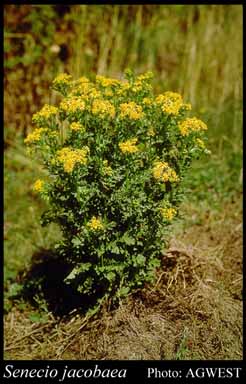- Reference
- Sp.Pl. [Linnaeus] 2:870 (1753)
- Conservation Code
- Not threatened
- Naturalised Status
- Alien to Western Australia
- Name Status
- Current
Short-lived biennial or perennial, herb. Fl. yellow, Sep to Dec or Jan to Apr. Moist soils.

Distribution
- IBRA Regions
- Warren.
- IBRA Subregions
- Warren.
- Local Government Areas (LGAs)
- Manjimup.
Management Notes (for the Swan NRM Region)
General Biology. Growth form. Herb. Life form. Perennial. Reproduction. Produces seed. Can reproduce from segments of the long-lived crowns.. Dispersal. spread by wind, water, animals, vehicles, humans and in contaminated agricultural produce. Seed dispersion is usually restricted to no more than 15 m, but segments from the crown can be dragged by machinery or animals, causing further dispersal. Seedbank persistence. Dormant seeds can survive for up to 20 years..
Notes. An upright and relatively perennial herbaceous plant on average 45-120 cm tall. Forms a basal rosette of leaves during the early stages of growth. Leaves are dark green and mostly hairless on top, and paler and hairy underneath. Bright yellow flower-heads (20-25 mm across) are in dense clusters at the tops of the branches. When the plant is damaged it gives off an unpleasant smell. The plant is poisonous to humans and livestock..
Additional information. Origin. Native to north-western Africa, Europe and western and central Asia..
Suggested method of management and control. Manual removal of the crown and all larger roots can be effective for seedlings. However, for deep rooted plants disturbance of the soil can expose buried seed to light which will lead to further germination. For spot spraying, apply to actively growing plant : Triclopyr 300 g/L + Picloram 100 g/L rate of 350 or 500 mL per 100 L of water, 2,4-D 300 g/L + Picloram 75 g/L rate of 300 mL per 100 L of water, MCPA 340 g/L + Dicamba 80 g/L rate of 190–270 mL per 100 L of water or Dicamba 500 g/L rate of 280 mL per 100 L of water Mature plants mostly require higher concentrations to be successful, therefore in areas of sensitivity, as seedling only control method may be required. This is where the older plants are left to die naturally, and chemical treatment is focused on the young seedlings. Read the manufacturers' labels and material safety data sheets before using herbicides. For further information consult the Australian Pesticides and Veterinary Medicines Authority to determine the status of permits for your situation or state.
References
- Leiss, K. A (2011) Management practices for control of ragwort species. Phytochemistry reviews : proceedings of the Phytochemical Society of Europe, 10 (1): 153-163.
- NSW WeedWise. (2018) Ragwort. Department of Primary Industries, NSW. URL: https://weeds.dpi.nsw.gov.au/Weeds/Ragwort - Accessed May 2019.
- Queensland Government (2016) Weeds of Australia. Identic Pty Ltd for Biosecurity Queensland URL: https://keyserver.lucidcentral.org/weeds/data/media/Html/senecio_jacobaea.htm - Accessed May 2019.